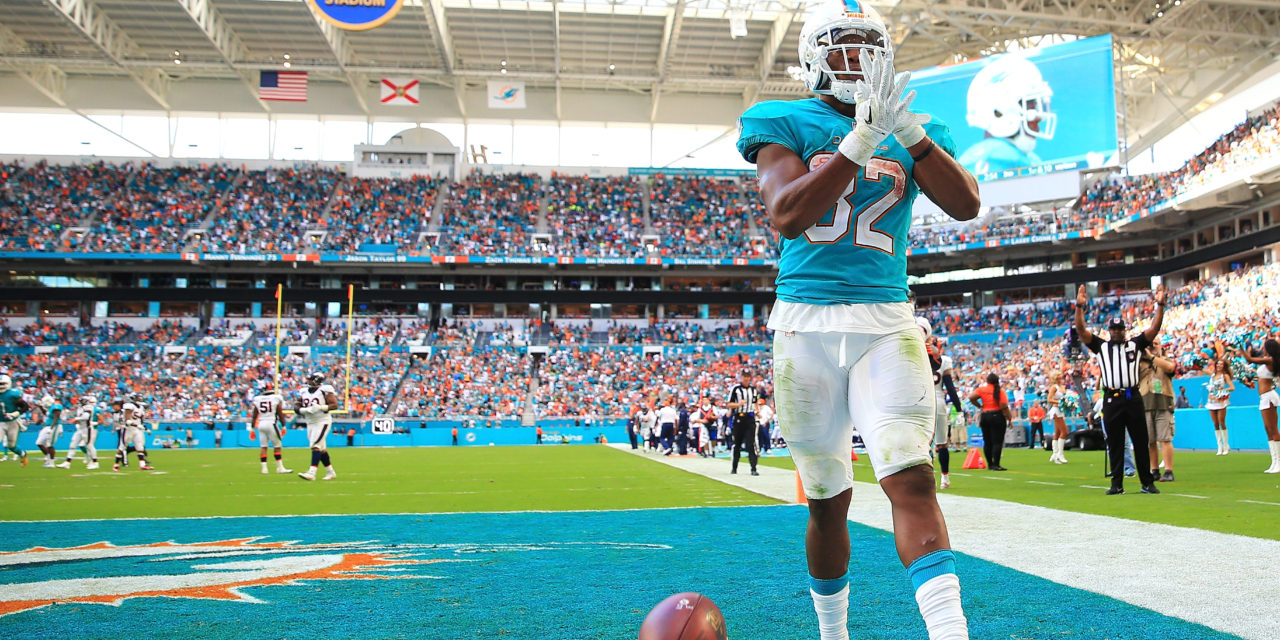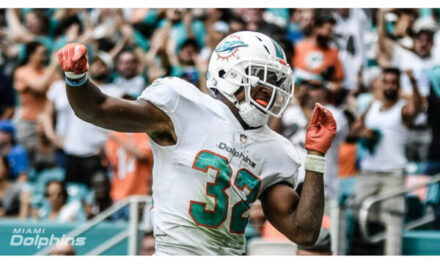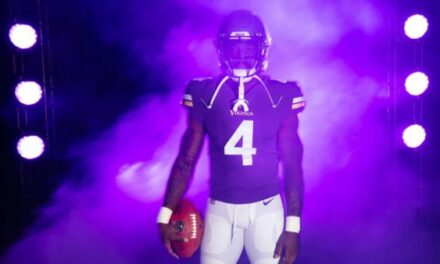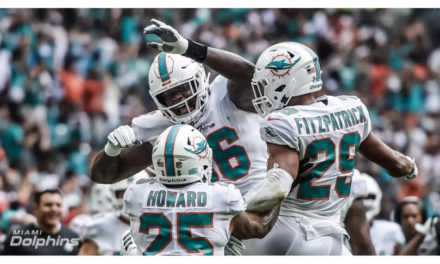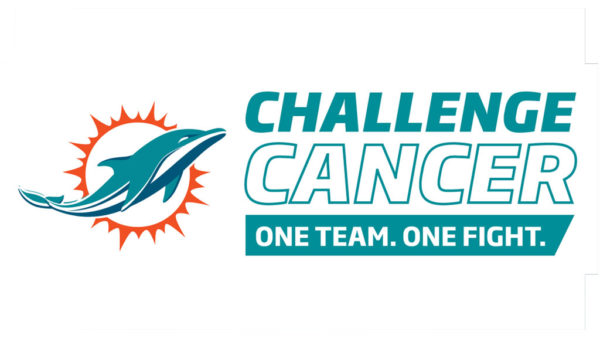This year brings a familiar yet different look for the Miami Dolphins backfield. Kenyan Drake, coming off a promising 2017 season is the familiar. After Jay Ajayi was traded, Drake took the starting reps from Damian Williams and never looked back. He seemed to get more familiar and fluid as the season wore on. Gone is Williams. A dependable back up that could grow into a bigger role if given more opportunities.
To fill that role, Miami brought in seasoned vet and Miami legend, Frank Gore. Gore is a solid if not above average player, even at his age. He has held up remarkably well over the years and had his second best rated season last year.
Kalen Ballage, the fourth-round pick, comes in with as much potential as any recent Miami Dolphin rookie. His size and speed and ability to catch the ball out of the backfield makes him an immediate threat in this offense. Three players and only so many touches to go around. How will Gase and the Dolphins distribute the ball?
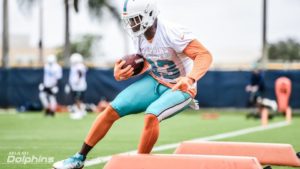
Kalen Ballage
Our sample size of Adam Gase being in charge of an offense is small but telling. 2014 was the first year that Gase was an Offensive Coordinator with the Denver Broncos after serving as the team’s Quarterback coach in previous years. That year, he essentially utilized four different running backs with C.J. Anderson and Ronnie Hillman taking most of the carries. Of the 384 carries attributed to the running backs, C.J. Anderson took 46% of the carries, Hillman took 27% of the carries and Montee Ball and Jwan Thompson combined to take the remaining 27% with identical 13.5% each. Receptions were doled out the same way in a season that saw C.J. Anderson go to the Pro-Bowl.
The following year, Gase was in Chicago, where his 423 carries were again distributed amongst four running backs, with Matt Forte taking 51% of the carries, Jeremy Langford taking 35%, Ka’Deem Harvey taking 10% percent and Jacquizz Rodgers carrying the final 4%. Reception wise Forte and Langford catching over 93% of the balls, predominantly by Forte. But we are seeing a pattern here, right? Maybe not.
2016, Gase’s first season in Miami, was the first deviation from his multi-player backfield rotation. After a failed Arian Foster experiment, Gase and Miami found success behind the brutal attacking running style of Jay Ajayi. For a Gase offense, the Dolphins carried a low 350 times (by running backs) but there was not the distribution we saw before. Ajayi carried an unbelievable 74% of the time towards a Pro-Bowl season. Damien Williams took 11% of the runs, while then rookie Drake took 9% of the carries. Foster’s wasted tenure as our starting running back took the remaining 6%. Reception wise however, Ajayi and Williams accounted for the bulk of the touches with 41% and 34% respectively. Gase went away from what made him successful and rode the work horse Ajayi to a 10-6 record and a Playoff appearance. He needed to come out a winner his first year.
Last year, was the same yet different. First, Miami running backs had an extremely low 317 carries. The offense was terrible however, with way too many three and outs. We were playing from behind most of the time having to throw the ball more than not. For the first 7 games, Gase tried to revert his 2016 plan of running the Jay Train. Ajayi took 44% of the overall carries by running backs during the entire 2017 season in the first 7 games. Drake took 42% of the total carries during his break-out season and Damien Williams took the remaining 14%. Of the 66 receptions by the running backs, Drake had 48% Williams had 30% and Ajayi had 22% of the Jay Cutler passes. While he started off the season running Ajayi into the ground (he was on pace for a 316-carry season) Adam Gase showed us flashes of his 2014 & 2015 teams where his running back distribution actually had a distribution within it. And those offenses actually having success. This showed the last 9 games of the season. Like in trading Ajayi, Gase forced himself to start being himself again. He got rid of his crutch.
What stands out to me is the low amount of carries over the past two years. I do not think it’s a surprise that these past two years have been Adam Gase’s two worst offenses to date. He needs to get those carries up to the high 300-low 400 mark. It goes without saying what a strong running game does for a quarterback. Our off-season improvements across the line and at tight end should also help. In the words of a great friend and a great fan, just Run the Rock Coach.
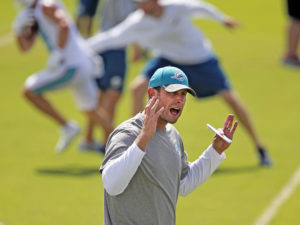
Adam Gase
I expect Coach Gase to go back to the style of play that we saw in his Bronco and Bears offenses. His running back by committee is not an even split. One player takes the bulk of the carries and a second back handles third down duties and well as spelling the starter. I expect a 45%-35% split with Drake and Gore this year. There also seems to be a younger player in the mix getting a small sample size hoping to impress, with Kelan Ballage picking up the scraps.
There is a good case to give Gore a more equal share of the carries this year. He is a bruiser. He can wear a defense down and serve as a catalyst to Drake’s change of pace speed. He can also help keep Drake young and fresh by absorbing a greater number of hits. While I do not expect that to happen I expect the gap to be slightly tighter than it was for Gase’s running backs in 2014 & 2015. I think Gore is going to surprise a lot of people this year with his play and could be relied on to ground and pound our way out of a tight game.
Drake is going to be Drake and I expect that he is the latest of Adam Gase’s running backs to make the Pro-Bowl. He is going to be a tremendous weapon for us both in the running and passing game and I hope for years to come.
Based on Adam Gase’s history, Ballage should see his share of work this season. His future and Miami’s future plan at running back will be based on what he does with those opportunities. It’s going to be interesting to see how this pans out with the use of these running backs and if we see more of the offensive distribution that gave Coach Gase success a few short years ago.

